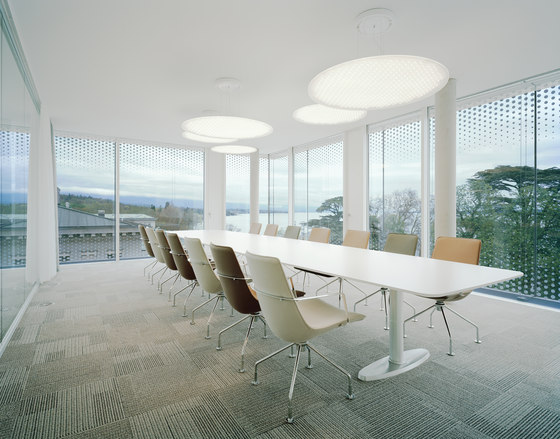A „Grand Vision“ realised architect Jens Wittfoht opts for Nimbus LED luminaires: They are an integral part of the energy concept for the WTO extension
One of the largest LED-lit buildings in Switzerland is situated on the shores of Lac Léman in Geneva. The light for its 300 office workplaces is provided exclusively by LED luminaires: the Wittfoht firm of architects from Stuttgart installed 447 ceiling, wall, suspended and floor-standing luminaires from Nimbus in the extension to the World Trade Organisation‘s (WTO) headquarters. As they consume up to 80 percent less energy than conventional luminaires, they have helped the new office block become the first building with a mirrored glass facade to comply with the applicable „Minergie-P“ energy standard.
At first glance the building seems to hover. The extension to the WTO headquarters is a long, transparent cube resting on an earthbound base. The new building blends in harmoniously with the surrounding parkland on the shores of Lake Geneva. It keeps a respectful distance to the main building, the Centre William Rappard, which was officially opened in 1926 and also features an adjoining conference centre from the year 1998. A glass footbridge joins the different parts of the building complex.
The ground floor of the extension accommodates the lobby and a restaurant with a terrace. The offices and administration are situated on the upper floors. The premises exude a quiet, calm and open atmosphere. „The Nimbus LED luminaires contribute to the atmosphere and the response from the staff has been very positive,“ commented the architect Jens Wittfoht with a distinct note of satisfaction. „The aesthetics and light colour of the Nimbus luminaires fit in wonderfully with our concept.“
Successful combination of architectural clarity and sustainable building
Clarity and sustainability are playing an increasingly significant role in the construction projects realised by the Wittfoht firm of architects from Stuttgart. In the planning of the new building for the WTO, for example, energy efficiency stood right at the very forefront of the firm‘s considerations: the building was completed last year and is the first building with a mirrored glass facade to meet the applicable „Minergie-P“ energy standard.
In order to satisfy the standard, Wittfoht Architekten used the water from the lake as an energy carrier and coupled it with an efficient technical system that also includes heat recovery. Nimbus‘s extremely economical and durable LED luminaires also contribute to the new building‘s energy efficiency. Efficiency and durability of the Nimbus LED luminaires were decisive As early as 2006 – when the field of LED luminaires was still unchartered territory – Dietrich F. Brennenstuhl, founder and CEO of the Nimbus Group, had „a grand vision“: he intended to make buildings even more efficient by using LED luminaires. The architect Jens Wittfoht was so convinced by this approach that he made the minimalistic LED luminaires from the Stuttgart-based enterprise an integral part of his energy concept for the WTO extension. As he later summarised: „The LED luminaires from Nimbus didn‘t only fit in perfectly with our plans from an optical point of view, but from an energy point of view as well.“
Clients and architects alike are impressed by Nimbus‘s ambitions to further reduce energy consumption and make LED luminaires the first choice for large-scale projects: „We regarded compliance with the „Minergie-P“ energy standard as a challenge,“ remarked Stefan Huml, Sales Manager of the Nimbus Group. And the Stuttgart lighting experts mastered the challenge brilliantly: 165 Office Air LED floor-standing luminaires with presence detector and ambient light sensor (PDLS) were installed in the building and they alone deliver an energy saving of 80 percent compared to conventional workplace luminaires. At 0.5 watts, their stand-by consumption is even lower than demanded by the applicable guideline for ecological design.
Control via the presence detector and ambient light sensor reduces consumption even further: the built-in ambient light sensor continuously measures the ambient light and makes ongoing adjustments to achieve a constant level of brightness. The presence detector switches the luminaire off just a few minutes after an employee leaves the workplace. When he or she returns, it automatically becomes light again.
Nimbus Group proves its know-how – in over 8,000 projects
Architects and lighting designers recognise the Nimbus Group‘s outstanding expertise in the field of LEDs and acknowledge that it gives them a reliable basis for their planning. Large numbers of Nimbus LEDs light up over 8,000 projects: planning for the WTO extension alone included 165 Office LED floor-standing luminaires, 140 Modul Q 64 ceiling luminaires, 69 Air Maxx LED 250 wall luminaires and 30 Modul R 256 XL, 17 Modul R 460 XL, 16 Modul R 120 XL and ten L 120 suspended luminaires: „These numbers make the WTO extension one of the largest office buildings in Switzerland lit by LED luminaires,“ Huml happily reports.
„Our project experience and our considerable design expertise have not only convinced architects but clients as well,“ the sales manager explains. Many clients ask to see projects that Nimbus has realised to help them in their decision: „For example, in 2010 we visited Unilever‘s new German headquarters in Hamburg‘s HafenCity together with representatives from the WTO. Nimbus fitted the building out with LED luminaires and it is even larger than the one in Geneva,“ reports Huml. „The visit dispelled any remaining doubts. They were particularly impressed with the low energy consumption of our LED luminaires.“ Wittfoht Architekten also intends to plan future projects with Nimbus: „Sustainable building means building for the long term,“ explains Thomas Kindsvater, the project manager at Wittfoht Architekten responsible for the WTO extension. „The Nimbus LED luminaires are an essential aspect of our approach. We are already planning further projects in which we intend to use Nimbus luminaires.“
Architektur: Wittfoht Architekten




















